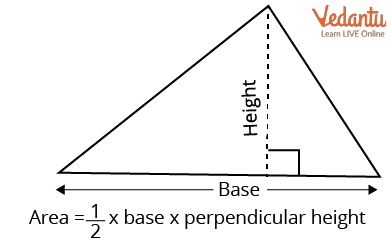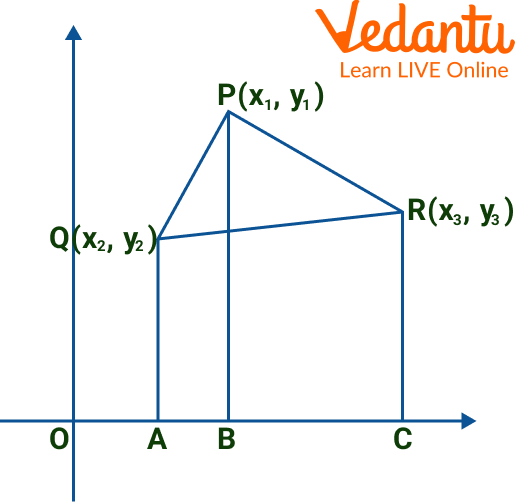




What is a Triangle?
Due to the word "tri," which stands for "three," the polygon with three sides is referred to as a triangle. Additionally, the name of the polygon suggests that it contains three angles. A polygon having three edges & three vertices is called a triangle. It is one of the fundamental geometric shapes.
The symbol for a triangle having vertices A, B, and C is ∆ABC. Triangles can be found in a variety of everyday objects, such as sandwiches, traffic signs, clothes hangers, and billiards racks. The area can be calculated using the formula "a =

Triangle
Area of a Triangle with Three Points
Area of Triangle with 3 Points Formula
In a two-dimensional plane, the area of a triangle is the area that it completely encloses. A triangle is a closed shape with three sides and three vertices, as is common knowledge. The entire area occupied by a triangle's three sides is referred to as its area. Half of the product of the triangle's base and height provides the general formula for calculating the area of the triangle.

Area of a Triangle
Area of Triangle with Coordinates of the Vertices
Triangle Vertices Formula
An ordered pair of real integers, known as the coordinates of that location, can be used to represent a point in a plane (sometimes referred to as a cartesian plane or a coordinate plane). Coordinate geometry is the area of mathematics that deals with employing coordinate systems to solve geometrical problems.
We will look at how to determine the area of the triangle using vertices if the triangle's coordinates are given. The area of the triangle is calculated if the triangle's coordinates are

Area of a Triangle with Coordinates
Area of
Sample Problems
1. If A(1, 2), B(4, 2), and C(5, 5) are the vertices of the ABC, respectively. What is the area of the ABC?
Ans: Here, the points are given as
As we know Area of
Substituting the values, we get
= Area = 4.5
Thus, the area of ABC is 4.5 sq units.
2. Find the area of the triangle formed by the points
Ans: Let
As we know Area of
Now by using the formula and substituting the values, we get
3. Find the area of the triangle whose vertices are
Ans: Area of
Substituting the values, we get
Area of triangle
Thus, the triangle is
Practice Questions
Let's solve the following area of the triangle with the formula.
1. What is the area of the triangle whose vertices are X(3, 3), Y(3, 4), and Z(7, 0)?
Ans: 2 sq units
2. What is the area of the triangle whose vertices are A(4, 1), B(4, 5), and C(5, 6)?
Ans: 2 sq units
3. What is the area of the triangle whose vertices are A(1, 3), B(2, 2), and C(3, 5)?
Ans: 2 sq units
4. What is the area of the triangle whose vertices are X(1, 6), Y(4, 2), and Z(8, 5)?
Ans: 12.5 sq units
5. What is the area of the triangle whose vertices are A(4, 4), B(2, 2), and C(5, 5)?
Ans: 0 sq units
Summary
Generally speaking, an "area" is the area included within the perimeter of a flat object or figure. Measurements are made in square units, with square metres serving as the reference unit (m2). There are predefined formulas for the computation of area for squares, rectangles, circles, triangles, etc.
This article taught us the formulas for the area of triangles for various kinds of triangles, along with several sample issues. As triangles are isosceles and equilateral, they all have the same formula. The formula for the area of a triangle can be determined by using the Pythagorean theorem.
FAQs on Area of Triangle With 3 Points
1. What are the different types of triangles?
The different types of triangles include an equilateral triangle, an isosceles triangle as well as a right-angled triangle.
2. What are the different properties of the triangle?
Three sides and three angles make up a triangle. A triangle's total angles are always 180 degrees. A triangle's outside angles are always a sum of 360 degrees. Successive interior and exterior angles added together are supplementary. Any two sides of a triangle can be added together to have a length larger than the third side.
3. What are the angles of the triangle?
In a triangle, there are three angles. Two of the triangle's sides are known as the vertex that meets at a common location to form these angles. Three inner angles added together equal 180 degrees. The side length generates an outside angle if we stretch it outside.











